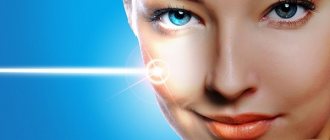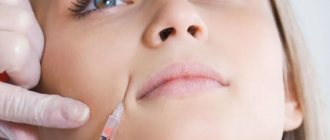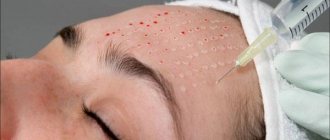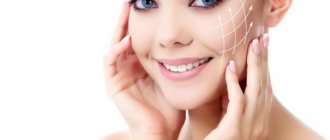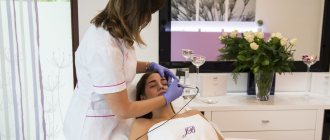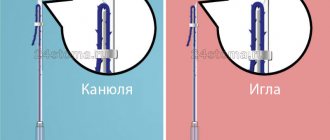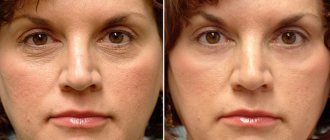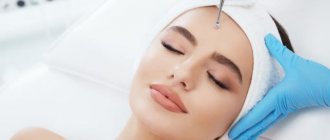Mesotherapy - what is it and when should it be done 10/31/2018 15:17
There are six injection mesotherapy techniquesContents
- Mesotherapy - what is it, indications.
- Methods of hardware mesotherapy.
- Fractional mesotherapy.
- Mesotherapy techniques.
- The effect of mesotherapy.
- Choice of meso cocktail.
- Preparing for the procedure.
- Stages of the procedure.
- How often should mesotherapy be done?
- Side effects.
- Contraindications.
Mesotherapy is a method of cosmetic medicine aimed at eliminating certain dermatological problems by introducing preparations containing vitamins, hyaluronic acid, phospholipids, etc. under the skin.
Mesotherapy is indicated for the following problems:
- Expression wrinkles.
- Age wrinkles.
- Enlarged pores.
- Flabby, thin skin.
- Gravitational ptosis.
- Cuperosis.
- Scarring.
- Stretch marks.
- Dark spots.
- Acne.
- Cellulite.
- Hair loss and alopecia.
There are two types of mesotherapy:
- hardware - a method in which medicinal substances are injected under the skin using special devices.
- injection, drugs are injected under the skin using a syringe through punctures.
Session outline
The vascular stage always begins with a diagnosis of the treated area by a cosmetologist. To do this, he carefully examines the skin on it, asks the client about the presence of contraindications and what symptoms. If necessary, tests are prescribed.
After the examination, the master prescribes medications and cocktails to perform the procedure.
The technology itself is carried out according to the following scheme:
- The skin is cleansed using a special medical composition and treated with a disinfectant solution of Chlorhexidine.
- The selected drug is drawn up with a syringe with a thin, cosmetic needle.
- The cosmetologist performs a series of injections along the spine.
- Next, another 10-15 punctures are performed along horizontal lines, based on where you plan to perform mesotherapy.
- At the end of the session, excess drug is removed and the skin is re-treated with Chlorhexidine.
- A soothing lotion is applied.
Since a special thin needle is used for the procedure, it most often does not cause severe discomfort to the girl, which is why no anesthetic is used. However, if the pain threshold is low, a local anesthetic can be applied before the session.
Fractional mesotherapy - its features and advantages
The essence of this type of hardware cosmetology is multiple effects on a specific problem area, using a handpiece equipped with a replaceable cartridge with needles of various lengths. Their number is from 12 to 20 pieces. The cartridge is selected depending on the problem, its location and the individual characteristics of the patient.
The needles make several thousand oscillatory movements per minute, due to which the area of influence is increased, and the pain of the procedure and its duration are reduced.
The effectiveness of the method is based on a double action:
- Inflicted microtraumas activate metabolism and regeneration processes. Stem cells are mobilized to build new tissue to replace damaged tissue. The production of collagen and elastin is stimulated. The skin is noticeably renewed within the first day after the mesotherapy procedure.
- During exposure, the drug penetrates into the deep layers of the skin. Its components participate in the biochemical processes occurring in the dermis, providing a prolonged, therapeutic effect. Therefore, the effect of the complex of procedures lasts from six months to one and a half years, depending on the individual characteristics of the skin.
How many procedures do I need to undergo?
This depends both on the problems being solved and on your age.
As a rule, cellulite treatment requires 5 to 15 sessions, volume reduction - 4-10, scalp treatment - 10-15. Improving the quality of the skin and tightening the oval face will require 4–8 procedures, and removing hernias under the eyes will require 1–4.
In the end, I did 15 procedures. And indeed, after the last 5, the acne disappeared very quickly. Plus, the acne itself has become much smaller. And their character has changed - they do not leave red spots behind and leave in English, politely and without saying goodbye. How to deal with acne? Vera's treatment history.
This depends both on the problems being solved and on your age. Facial mesotherapy is such an individual method of skin rejuvenation that it can be adjusted to your capabilities - both time and financial.
In many positive reviews, mesotherapy is mentioned as the most flexible method of lifting and rejuvenation. Therefore, your doctor can determine the exact number of procedures.
Typically, cellulite treatment requires 5 to 15
sessions, volume reduction – 4–10, scalp treatment – 10–15. Restoring the oval of the face will require 4–8 procedures, and removing hernias under the eyes will require 1–4.
Mesotherapy techniques
Injection mesotherapy, due to its effectiveness, has become the most popular method. It allows the specialist to deeply work on each area of the patient’s epidermis, individually selecting the number and depth of punctures and using various techniques for administering the drug.
There are six injection mesotherapy techniques:
- Papular. The needle is inserted under the skin at an angle. When injected, a small papule is formed, which ensures a long-term effect of the drug. Outwardly, this technique resembles the well-known mantu test and is used mainly on the face.
There are two options for using this technique:
- Surface. The depth of drug administration is no more than two millimeters; needle tilt 10 - 15°; The diameter of the papule is 1.5 - 2 millimeters. Used in the forehead, cheekbones, lower jaw.
- Average. The depth of exposure and the size of the papule are 2 - 3 mm; needle angle 45°. Used to treat blood vessels.
- Nappage. A series of multiple injections performed over a large area. Depending on the depth of the puncture, it is divided into three types:
- superficial, the area of the epidermis is involved, at a depth of no more than 0.5 mm. The needle is inserted at any angle. The distance between punctures is no more than one centimeter. Performed on the face, neck and décolleté;
- average. The needle insertion angle is 45°. Depth - no more than one and a half millimeters. Used for the treatment of vascular diseases. The appearance of “blood dew” is possible, because the walls of blood vessels are damaged;
- deep. It is used, as a rule, on the body, in the treatment of fat deposits and cellulite. The needle is inserted to a depth of at least ten millimeters, perpendicular to the surface of the skin, then the drug is infiltrated.
- Retrograde-linear. The needle is inserted under the skin along its entire length, forming a channel, which is filled with the drug on the return stroke of the needle. Used to correct wrinkles and folds.
- Separate injections. The needle is inserted into the skin fold to a depth of 4 mm. The injection volume is no more than 0.2 ml.
- Systematized acupressure mesotherapy. Similar to the previous technique, only the puncture site is selected taking into account the principles of reflexology.
- Scarification. The drug is applied to the surface of the skin. Then the specialist makes frequent punctures on it with a needle at a distance of 3 - 5 mm.
How is it carried out?
Vascular drainage is done according to a special acupuncture scheme. The first step is to perform injections along the spinal column from top to bottom and evenly. First, small doses are injected between the processes of the vertebrae, after which they are administered paravertebrally on both sides at a distance of 1.5 and 2 cm.
At the second stage, injections are made in several rows along the spinal line on the right and left at a distance of 4 and 6 cm. If the chest, neck, shoulders and face are being treated, then injections are made in two rows along the skull between the earlobes. The distance between the lines must be exactly 5 mm.
To complete the initial stage, specialists use the following medications:
- Vasodilators .
- Medicines that improve drainage of the lymphatic system.
- Venotonics , preventing the dilation of veins, restoring venous outflow.
- Medicines that have a vasoprotective effect, normalizing blood microcirculation.
After completing the vascular period, the doctor begins the subsequent stages of mesotherapy. In the presence of cellulite or obesity, such stages most often include surgical removal of fat mass and skin tightening.
The effect of mesotherapy
The effectiveness of the mesotherapy procedure is due not only to the ability to transport active substances directly to the problem area, but also to the activation of regenerative processes that awaken as a result of violation of the integrity of the skin.
The result of the mesotherapy procedure is:
- Strengthening the production of collagen and elastin. Microdamage to the skin causes stimulation of regeneration processes, which, in combination with the effects of hyaluronic acid and biologically active substances, give an amazing rejuvenation effect. Small wrinkles are smoothed out and deep wrinkles are reduced.
- Blood circulation increases. Improves complexion. Stagnant pigment spots disappear, skin tone and texture are evened out.
- Acne manifestations decrease or disappear.
- Stretch marks and scars disappear or become less noticeable.
- Adipose tissue is actively broken down.
The first stage of cosmetic elimination of body flaws
According to the proven methodology, vascular mesotherapy is treated in several stages. At the first stage of treatment, the mesotherapist draws up a personal card for the patient, where the entire medical history is entered and, on the basis of this, the necessary drugs for injection are selected. Traditionally, a course of mesotherapy is carried out twice a week and can be up to six individual sessions. It begins with homeopathy and, although the positive effect is not achieved immediately, it is very persistent. For this procedure, the skin must be disinfected, and the places where the therapeutic cocktail is to be injected must be anesthetized. This is done through the use of appropriate creams. The drug is injected to a depth of 10 mm with a needle or a special gun.
In order for the course of mesotherapy to be more effective, the vascular stage of this process is extremely important. During its implementation, blood microcirculation is activated, and the capillary walls become stronger and more elastic. At this stage, possible microthrombi are eliminated, blood circulation is normalized, which allows for a better supply of oxygen to the tissues and a more active removal of metabolic products. As a result of this effect, the skin is not subject to inflammation, and its cells are reliably protected from the harmful influences of the environment.
A course of mesotherapy can include up to 4 vascular stages, and, starting from the third procedure, vitamin and medicinal injections can be used, which should be injected directly into the problem area on the patient’s body. Sometimes you can do without continuing injections, because the desired result is achieved at the first vascular stage. This is important for preventing signs of aging and maintaining the beauty of healthy skin at a high level.
Meso cocktail selection
The composition of the drug is selected according to indications, depending on the nature of the problems, age and individual characteristics of the patient.
List of main components of meso cocktails:
- Hyaluronic acid is one of the most popular ingredients for mesotherapy. Its action is aimed at eliminating the signs of aging. Moisturizes the skin. Stimulates the synthesis of skin proteins.
- Aloe extract. Promotes tissue regeneration and normalizes water balance.
- Ginkgo biloba extract. Used for anti-aging therapy. Improves blood circulation, strengthens the walls of blood vessels.
- Gentamicin sulfate is an antibiotic drug used to treat severe forms of acne.
- Glycolic acid - used to prevent age-related changes, treat acne and seborrhea. Eliminates hyperpigmentation, atrophic scars and stretch marks.
- Aminophylline. Promotes the breakdown of fat. Used for the treatment and prevention of cellulite and fat deposits.
- Artichoke extract. Relieves swelling. Also used around the eyes. Used in the treatment of cellulite, especially its edematous form. Reduces post-traumatic swelling after plastic surgery, deep peelings and injections. Eliminates the effects of Botox overdose.
- Hyaluronidase. Moisturizes the skin. Eliminates wrinkles. Removes toxins. It is used for the treatment of fibrous cellulite and the treatment of scars.
- Vitamin preparations:
- Ascorbic acid. Used for increased pigmentation. Improves skin color and tone. Eliminates the initial signs of aging and wilting, facial wrinkles and spider veins. Restores skin elasticity and prevents the appearance of ptosis.
- Aflutop. Helps maintain tissue elasticity. Participates in the natural synthesis of hyaluronic acid and collagen, stimulates the restoration process.
- Vitamin A (retinoic acid). Powerful antioxidant. Slows down the aging process. Stimulates collagen production and skin renewal, making it denser. Has a healing effect.
- Vitamin B1. Effectively eliminates signs of aging. Used to treat hair, promotes hair restoration and stimulates growth.
- Vitamin B2. Stimulates regeneration processes and is used in the treatment of acne, dermatitis and eczema.
- Vitamin B3. Actively used to prevent age-related changes in the skin, rejuvenates and moisturizes it. Used in the treatment of cellulite, atrophic scars and stretch marks.
- Vitamin B5. Activates the process of tissue regeneration. Promotes skin renewal. Increases the strength of collagen fibers.
- Vitamin B6. Eliminates dryness and relieves skin inflammation. Used for hair treatment.
- Vitamin B8. Used for seborrheic dermatitis, focal baldness, hair loss, as well as for the treatment of acne and stretch marks.
- Vitamin B12. Evens out skin tone. A powerful remedy in the fight against hyperpigmentation.
Is it true that the procedure is also beneficial for hair?
Indeed, scalp mesotherapy is one of the most effective methods of treating hair loss, fragility, dryness, and split ends.
Clinic specialists select medications that stimulate blood circulation in the skin and hair follicles. They contain vitamins, microelements, amino acids and other hair nutrition components.
As a result, hair growth is normalized, its structure and appearance are improved, and sebum secretion is normalized. Mesotherapy for hair has a long-term effect and often helps to cope with complex problems such as baldness and early gray hair.
One of the drugs used in our clinic is NCTF 135. Our doctors often combine the use of NCTF with plasma therapy.
There are specially developed drugs for the prevention of dull hair color and hair loss, for example HairX.
Preparation for the mesotherapy procedure
In order for the mesotherapy procedure to be most effective, during the course you need to adhere to several rules:
- Minimize skin exposure to ultraviolet radiation and use sunscreen with an SPF level of at least 40.
- Stop using blood thinners.
- Do not visit the sauna or bathhouse.
- Reduce physical activity. Before and after the session, it is better to give up fitness.
- Don't drink alcohol.
Treatment is divided into three stages:
- preparatory stage No. 4
- main course No. 6
- preventive 1-2 times a month
Considering the timing of skin regeneration, it is not advisable to prescribe the mesotherapy procedure more often than once every 5-7 days. On average, the course lasts 8-12 procedures. After completing the main course, it is recommended to continue it in the form of preventive injections performed no more than once every 2 weeks. To reduce discomfort before the procedure, you can use anesthesia in the form of local applications of Emla or Anestop cream.
Stages of the mesotherapy procedure
A mesotherapy session, regardless of its type, consists of several stages. Before starting, the doctor conducts a consultation during which he determines the method of treatment and the composition of the meso-cocktail. Then goes directly to the procedure:
- The patient's skin is cleansed and degreased.
- An antiseptic composition is applied.
- The syringe is filled with the drug or it is applied directly to the patient’s skin if the procedure is carried out using a manipulator.
- The specialist proceeds to influence the patient’s skin, depending on the chosen technique: makes injections or makes multiple punctures of the skin surface.
- At the end of the procedure, an antiseptic cream and a soothing mask are applied to the skin.
During the day after a mesotherapy session, you need to maintain a gentle regimen and avoid exposure to ultraviolet radiation. You can use cosmetics only after traces of inflammation disappear.
Cocktail ingredients
The main ingredients when preparing a solution for vascular mesotherapy are:
- ginkgo biloba;
- melilot extract;
- arnica (ram);
- pentoxifylline;
- routine;
- silicon of organic origin.
The final decision regarding the composition of the drug is made by the cosmetologist after a thorough examination of the patient.
To carry out this stage of mesotherapy, doctors can resort to the use of medications, which are divided into several main types:
- With a vasodilating effect.
- Lymphatic drainage effect.
- Venotonics.
- Compositions that have a vasoprotective effect, improving microcirculation.
Side effects of mesotherapy
Despite the fact that mesotherapy is a low-traumatic procedure, both during the process and for several days after it, some complications may be observed:
- Painful sensations of varying severity. Depends on the depth of exposure and the patient’s pain threshold. During the session they are eliminated by applying a special anesthetic cream. It is worth considering that the use of additional funds may reduce the effectiveness of the mesotherapy procedure.
- Erythema and swelling. They can be observed from several hours to several days after exposure, depending on the individual characteristics of the patient and the drug used.
- Hematomas. They occur most often on the body, because... In this case, the drug is administered quite deeply. On the face, such manifestations are possible if there is weakness of the vascular walls.
- Allergic reactions. They manifest themselves in the form of swelling, itching and rashes. Most often they are a reaction to the components of the mesotherapy drug. For this reason, people with a tendency to allergies need to warn their doctor about this feature and be more careful in choosing the ingredients of the mesococktail. In rare cases, mechanical urticaria may occur as a reaction to microtrauma.
Usually, all these phenomena disappear within a few days without additional therapy. If your condition worsens, you should immediately consult a doctor.
Contraindications
Like any medical procedure, vascular drainage has a number of contraindications:
- Allergy to components included in medicinal cocktails.
- Oncological neoplasms.
- The course of acute inflammatory processes.
- Phlebeurysm.
- Diseases of the cardiovascular system.
- Diabetes.
- Some types of skin diseases.
- The period of gestation and lactation.
Before starting vascular mesotherapy, the specialist must conduct a complete collection of the patient’s medical history and give permission for the procedure only after thoroughly familiarizing himself with the symptoms of certain diseases.
In case of mild diabetes mellitus, the patient may be prescribed drainage mesotherapy, subject to the restrictions stated by the doctor.
